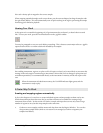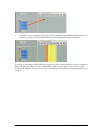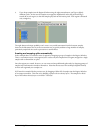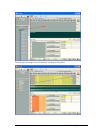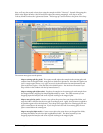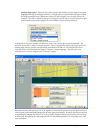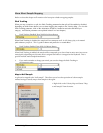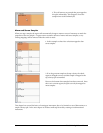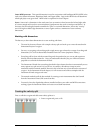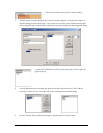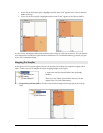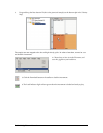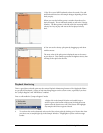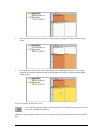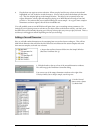
TASCAM GigaEditor 4 Manual 39
Chapter 3: Tutorial: Creating a Multi-Dimensional Instrument
In the simplest possible Giga instrument, each region would be mapped to a single sample, and you would
hear that sample whenever one of the region’s keys is pressed. However, regions are usually divided further
into dimensions. e example we’ve already seen is a velocity dimension, which causes dierent samples to
sound depending on how hard the player is striking the keys. If there are four samples available, each
mapped to a dierent part of the velocity range, we would say that the velocity dimension has four splits.
In a Giga instrument, the dimension concept can be multiplied many times over. For example, an
instrument sampled at four dierent velocities might also be sampled using ve dierent playing styles, for
a total of twenty unique samples per key. “Playing style” thus becomes a second dimension with ve splits.
When we assign a MIDI controller to this new dimension – let’s say the Mod Wheel – the sampler will now
use both velocity and the Mod Wheel to choose among the twenty samples.
In this chapter we’ll create a two-dimensional instrument. We’ll begin with a simple velocity split then add
a second dimension to show how the dimensions interact. In the Giga architecture, going beyond ordinary
velocity splits opens up a world of possibilities, so rst we’ll take a short detour through the full list of
dimension types.
Types of dimensions
Every dimension has a control source, which may be a traditional MIDI controller, a simple algorithm, or a
complex piece of logic such as an Intelligent MIDI Rule. We list the possible control sources here, starting
with the most basic.
Velocity. is is the traditional “velocity switch”, typically using the velocity with which the key is struck
to select among samples recorded at various dynamic levels.
MIDI continuous controllers. When a MIDI controller is assigned to a dimension, the value of that
controller at note-on determines which split will sound. Examples include using the Mod Wheel to switch
between closed and open hi-hats, or using the Sustain Pedal to switch between piano samples recorded with
and without sustain.
Keyboard. Keyboard (or “Keyswitch”) control allows changing from one split to another by striking
otherwise unused notes on the MIDI keyboard. is is oen used for orchestral instruments that have a
large number of articulations, where it would be dicult to switch accurately using a wheel or pedal type
controller. e area of the keyboard used for switching is called the keyswitch region, and is dened in the
Instrument Properties dialog.
Layer. e Layer dimension is unique in that all of its splits sound simultaneously, instead of just one.
Layers are sometimes used in conjunction with MIDI volume control and/or crossfades, to give continuous
control over the volume of each layer.
Release trigger. is special type of dimension typically has two splits and is used with sounds that have
been divided into separate sustain and release samples. When a note on is received the rst split is always
played. e sample mapped to the second split is played at note o.
Round Robin, Random. ese dimensions switch samples automatically each time you play a note. Round
Robin progresses through the splits in order, while Random triggers the splits randomly.
Round Robin across keyboard. is variant of the Round Robin dimension advances to the next split
when a key is struck in any region. (e basic Round Robin dimension described above advances only
when a key is struck in its own region.)



